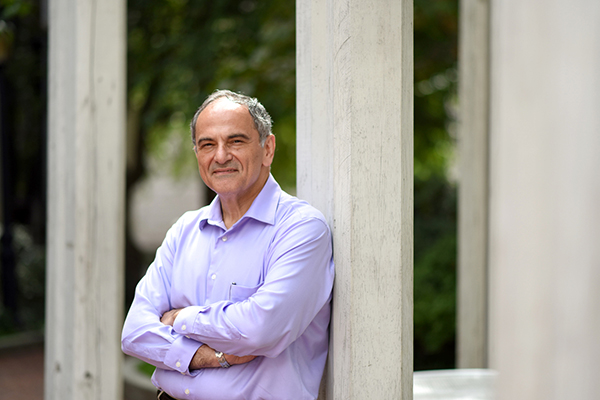Advancing Northeastern’s leadership in drug discovery

Diomedes Logothetis, the new chair of the Department of Pharmaceutical Sciences in the School of Pharmacy, has a vision: To advance Northeastern’s standing as a go-to institution for academic researchers interested in drug discovery.
“Northeastern has the pharmacological, biochemical, and biophysical knowledge to make the molecules that will become the next generation of drugs,” says Logothetis, who served as chair of the Department of Physiology and Biophysics at Virginia Commonwealth University School of Medicine before coming to Northeastern. “Other places don’t have that range of expertise. We can be the engine driving the understanding of how new drugs act, what molecules in the body they bind to, and how their structure affects their function.”
Logothetis’ roots at Northeastern run deep. He received his bachelor’s degree in physics from the university in 1980 and his master’s in psychology in 1981. “I love how the university has grown since I was here,” he says, admitting to a sense of déjà vu as he passes buildings, such as Nightingale Hall, where he took classes decades ago.
A new type of antipsychotic
In his lab, Logothetis will investigate how certain proteins in our cells’ membranes are regulated and what happens when that regulation goes awry. The aim is to develop new drugs that can then correct the imbalance.
We need to appreciate how this fundamental mechanism translates into disease when things don’t go well. Then we can design molecules that either inhibit or activate the mechanism in the proteins that are malfunctioning.
— Diomedes Logothetis, professor and chair
One line of his research explores membrane proteins called ion channels. These proteins function as gateways for charged particles of various elements—potassium, say, or calcium—to travel into and out of the cell, generating the electrical currents that permit our cells to communicate with one another. That communication underlies everything we do: see, digest, pump blood through the body. If a mutation in an ion channel interrupts that communication, disease and other health conditions result. For example, a malfunctioning ion channel in heart cells could lead to severe cardiac arrhythmia.
“We need to appreciate how this fundamental mechanism translates into disease when things don’t go well,” says Logothetis. “Then we can design molecules that either inhibit or activate the mechanism in the proteins that are malfunctioning.”
Another line of research looks at a protein that acts as a receptor on many cells, including brain cells—it’s the “lock” into which chemicals in the brain called neurotransmitters fit to launch the events that will provide operating instructions to the cell. People with schizophrenia may have an imbalance of these receptors: The receptors that fit the neurotransmitter serotonin, a calming chemical, may outnumber those that fit the neurotransmitter glutamate, an excitatory chemical. To be effective, antipsychotic drugs must target both types of receptors.
In an earlier breakthrough paper, Logothetis and his colleagues reported that serotonin and glutamate receptors were what’s called “inversely coupled,” that is, each essentially canceled out the action of the other. “The active state of one caused the inactive state of the other, and vice versa,” he says. The finding opened the door to a possible new type of antipsychotic therapy. “You could give people two different drugs at once, each targeting a particular receptor, or you could even tether them together and make one drug out of two,” he says. “The latter is hard to do, but it’s possible.”
Northeastern’s interdisciplinary focus will be a boon to continuing these lines of research, says Logothetis. It will also open up new paths for collaboration.





